When you first start working with horses, it may seem like they don’t communicate much, aside from a nicker or whinny hear or there. But the truth is horses communicate all the time, with a subtle silent language.
It’s important to understand and interpret horse communication so that you are on the same page and you are not irritating, confusing, or pushing a horse beyond what they are ready for. Clear communication is key to a good horse-human relationship. The more you know about how your horse communicates, the easier it will be to ride, train, care for, and have fun with them.
How do horses communicate? Horses use sounds and body language to communicate with other horses, animals, and humans. However, when it comes to horse-human communication, body language is the primarily used method. These cues include movements of the horse’s ears, eyes, tail, legs, body, and overall mood.
Whether you are new to horses or simply want to better understand horses, familiarizing yourself with typical body language signals will make a difference in how you handle and work around horses.
In this post, I’ll explain some of the basic ways horses interact with humans as well as other horses. Then I will go over some of the messages that your horse may be attempting to communicate to you through their body language.
Methods Of Horse Communication
Like I said horses use vocals and their bodies as their 2 main methods of communication. Which you will quickly learn as you spend more and more time around them.
In terms of communicating with other horses, voice signals are used more often, than with humans. Recognizing your horse’s vocal cues can give you some insight into their thoughts and feelings, but observing their body language offers a more accurate method of Interpretation.
Be aware that each horse will have their own set of body language cues. So it makes sense not to rush learning your horse’s unique signals. When dealing with a new horse, this can be frustrating since you may not recognize all of the cues they are giving you.
Learning horse body language signals and vocal sounds will help you become a better listener, trainer, and partner.
Horse Communication With Humans
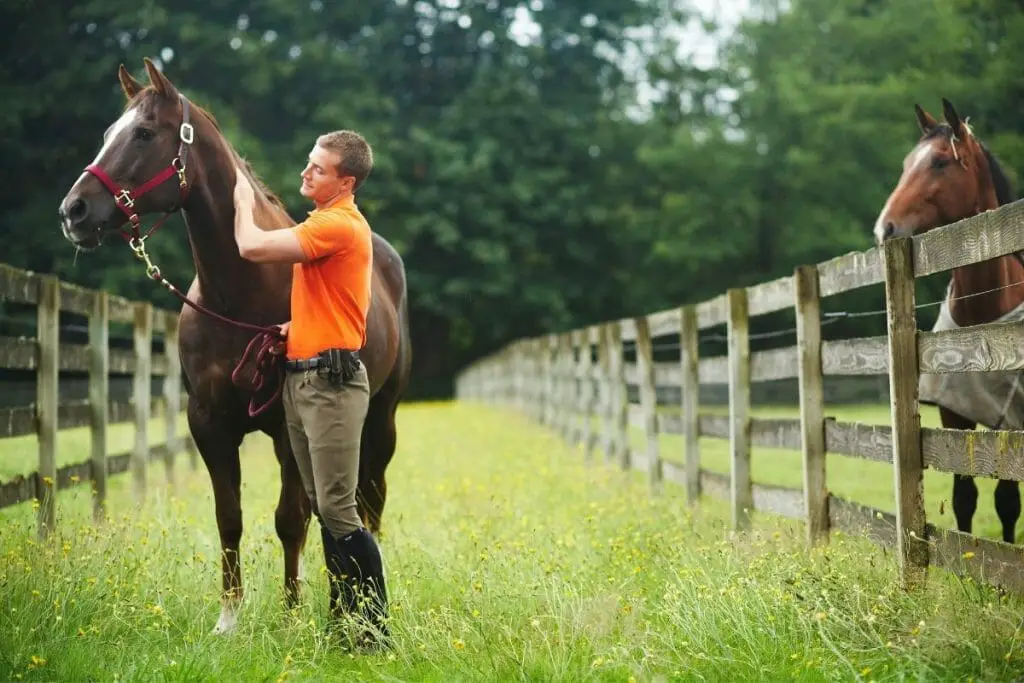
Clear communication is essential for any horse-human partnership to thrive. This is particularly the case if you are actively training your horse to compete, ride, or even improve basic groundwork. Without effective communication, you could be thrust into an unpredictable and potentially dangerous predicament.
When working with horses, many people rely too heavily on their voices.
Horses can understand the intent by the tone of our voice but can’t understand what we are actually saying. To get our horses to cooperate, we need to exhibit our leadership through our body language and the exercises we have them do.
However, some experienced equestrians know this and talk out loud anyway when working with horses, because it helps to manage their own feelings.
That being said horses are highly sensitive to human emotions. Your horse will be able to tell right away if you’re sad, irritated, or nervous. Body language can reveal your emotions even if you try to keep them hidden. This could convey the wrong message to your horse.
Although some people may speak verbally to their horses, body language should primarily be used when working with horses and always back up a voice command to make it clear to the horse.
Unlike humans, horses mainly communicate with us using body language. So not only do we have to pick up on the horse’s body language but we also have to be aware of our own.
How Horses Communicate In A Herd
When it comes to how a horse communicates with other horses, you’ll notice that it relies on its eyes, ears, head, and body position.
You may see a horse driving another horse away showing territorial behavior. Whether in the wild or a domesticated horse protecting their hay pile. They may put their head down, pin their ears, shake their head, lunge forward, chase then swing hindquarters.
Horses may also show submission in a herd. Such as a young horse clacking their teeth, showing they are vulnerable and not hurt them.
Horses often communicate with each other whether there is any potential danger or threats. This is why when one horse loses it more usually follows.
Learn more about horses as herd animals:
Horse Communication Sounds

In this section, you will find a quick overview of different sounds horses make and the general meaning behind the sounds. Just want to note that there can be more meaning than what is listed below but I shared the most common reasons.
When A Horse Whinny or Neighs
Whinnies are commonly used when a horse calls out to his buddies. They may have separation anxiety and are calling for their buddy to come to them, or to know where they are. Sometimes horses whinny when there is a new horse in the distance.
When A Horse Nickers
A nicker is a call for attention, welcoming, or approval. It is softer than a whinny. A horse may nicker when they see their favorite human, or their buddy came back to the paddock, or they are about to get dinner.
When A Horse Snorts
Snorting can mean a few things. They may be excited, clearing out their nasal passages,
When A Horse Squeals
Squealing is usually a sign of aggression. It commonly happens when new horses meet or when a female horse rejects advances from a male horse.
When A Horse Groans
Groaning can be good or not so good. When it’s okay the horse may be lying down or rolling and start groaning. Almost like when you wake up and stretch really hard and make a groaning noise. Or it can be not so good, if the horse say has colic, and is groaning in pain, while they lay down and roll. Groaning can also be a sign of pain while being ridden or in training., if the saddle doesn’t fit or something else is hurting them.
When A Horse Sighs
Sighing can sometimes sound similar to groaning. But it’s more like when you take a deep breath and let it go. Horses usually sigh when they are relaxed or feel good for the most part. Such as when they are being stroked or massaged, groomed, stretching. They may also sigh when they get a release of pressure.
When A Horse Screams
Horses usually scream for two reasons. They are about to fight. Or they have just gotten hurt and they feel agonizing pain.
VIDEO: On Horse Body Language
What Is Your Horse Saying?
Now that we know that one of the key ways in which your horse attempts to communicate with you is through their body, how do we determine what they are attempting to say? This silent language is quite similar to human body language, making it somewhat simple to decipher. Here are some frequent signals and their meanings.
When Your Horse Curls Their Upper Lip
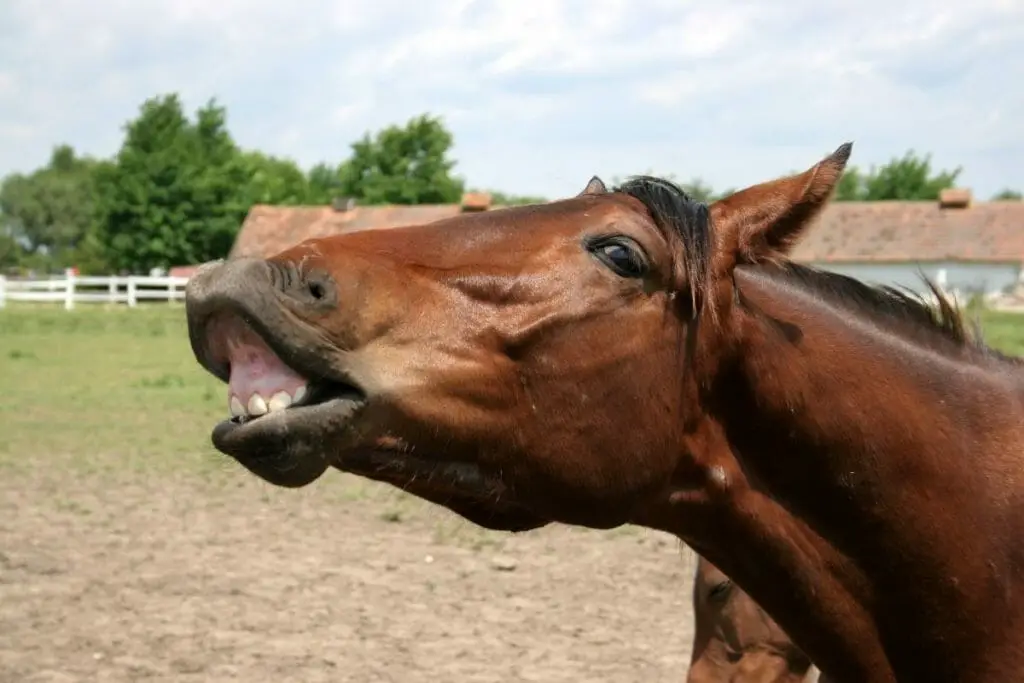
This is called flehmen response (upper lip curl). When your horse does this it exposes specific smells right to something called the vomeronasal organ.
Many horses do this when they are introduced to a strange taste or smell.
Some examples:
- When a horse gets medicine
- Given a new treat
- Male horse smells female urine
Your Horse Is Saying They Are Relaxed
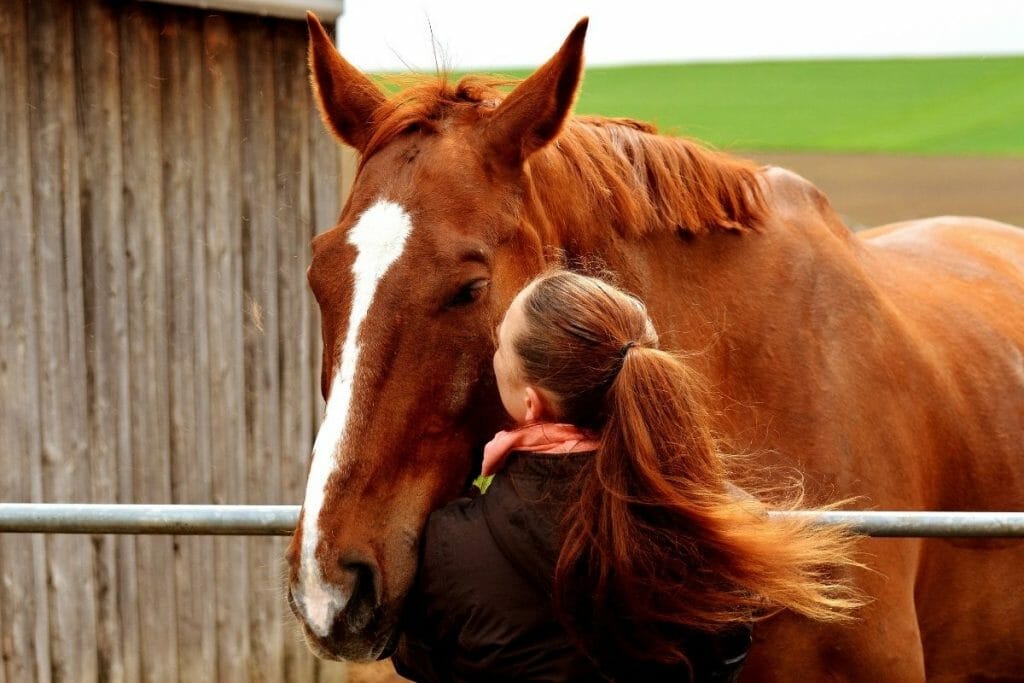
A horse can show signs they are relaxed whether they are standing or moving around even being ridden.
Signs your horse is relaxed while standing around:
- Saggy lips
- Relaxed hind leg
- Drooping tail and neck
Signs your horse is relaxed while moving around:
- Loose swinging tail
- Lowered head
- Relaxed mouth
- Ears out to the side floppy
Your Horse Is Saying They Are Scared
A horse can easily become scared if a situation or object seems threatening to them. Their body language is much different than a relaxed horse.
Signs your horse is scared:
- Tensed muscles ready to flee
- Large open nostrils
- Lifted tense tail
- Wide eyes may be able to see the whites
- Moving ears back and forth
- Head lifted high
These signs get picked up real quick by other horses. Before you know it all the other horses are acting this way and looking for potential danger.
Your Horse Is Saying They Have An Illness or Injury
There are many people that miss the body language when a horse is sick or hurt. This can be displayed in different ways. Some people may think the horse is just relaxed when actually the horse is really sick. Or the horse is misbehaving because of a bad mood or temperament but it could be soreness or injury.
Signs your horse is sick:
- Quiet and uninterested
- Has a lower level of energy
- May not be interested in food
- Horses eyes look sad
- Head lowered
- The tail may be clamped
- Excessive rolling
- Lying down more than normal
- Biting at stomach
- Acting up under saddle, such as not wanting to move, kicking out, biting, bucking
Signs your horse is injured
- The horse may also have a sad expression
- Whites of eyes may show
- Tightness in jaw and mouth
- Lameness or stiffness
- PinneWhy Horses Pin Their Ears Back! What They are Signalingd ears and overall grumpiness
- Acting up under saddle, such as not wanting to move, kicking out, biting, bucking
Your Horse Is Saying They Are Stressed and Anxious
Horses stress and get anxiety just like us. Whether they moved to a new barn, are under a heavy workload, living conditions do not meet their needs, they’re competing at shows, under a new training regime, and more. These are just some things that can cause horses stress or anxiety. The body signals are similar to a horse experiencing fear.
Signs your horse is stressed or anxious:
- Tail raised
- Eye and nostrils are wide
- The body is stiff with their head carried high
- Ears pointed forward
- The horse may have nervous tendencies such as weaving, stall walking, pawing
Chronic stress can cause long-term issues for your horse. They become more susceptible to illnesses and ulcers.
Your Horse Is Saying They Are Sad or Depressed
Horses can be sad or depressed. It is similar to how a human displays sadness or depression.
Signs your horse is depressed:
- Eyes wide open but ears are still
- Not interested in anything around them
- May refuse food
- Often will stand still facing the corner of the stall
- Head hangs low
They may look similar to a horse that is sick and doesn’t feel well
Your Horse Is Saying They Are Discontent
Horses can be discontent with a situation. This is the point before they are totally stressed out or angry. They are just trying to communicate that they are not happy with something. You may be handling them, grooming, or riding. Maybe they are bored, or uncomfortable.
Signs your horse is discontent:
- Pulling
- Shaking head
- Swishing tail frequently
It is important to know when a horse is displaying discontentment because you don’t want it to lead them into becoming stressed out or angry.
Your Horse Is Saying They are Angry
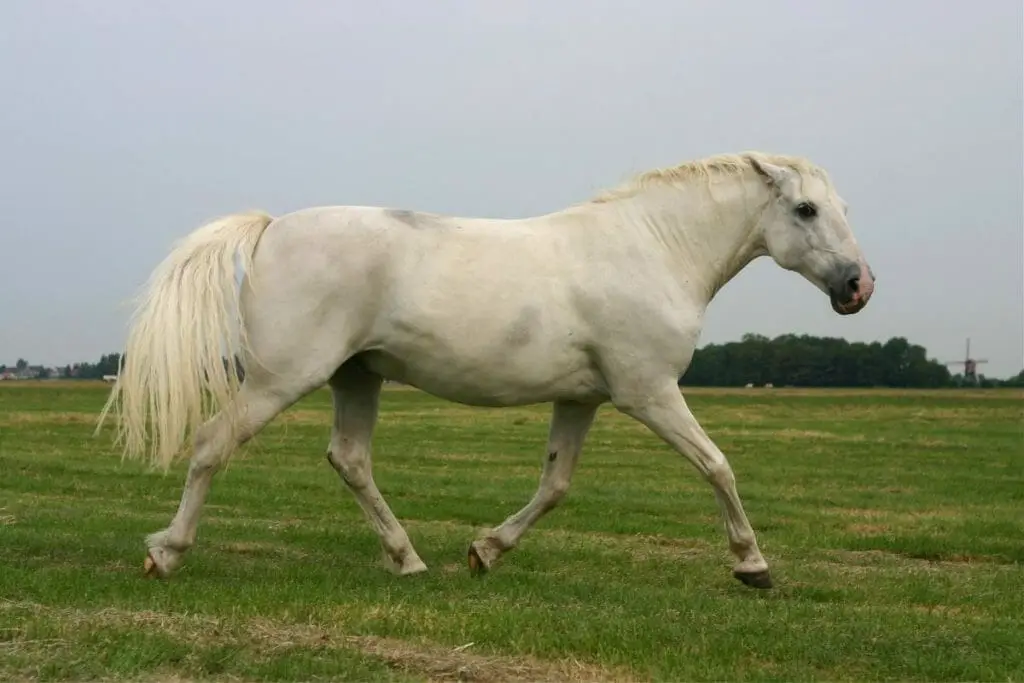
The key to avoiding injuries caused by a horse’s anger is to recognize the signs of anger in the horse, to begin with. There would be far fewer equine-related mishaps if people only paid attention to the horse’s body language. Horses rarely lash out without giving warnings first. By being familiar with an angry horse’s body language, you’ll be able to avoid potentially dangerous situations.
Signs your horse is angry:
- Pinned ears
- Tense muscles
- Whites of eyes showing
- Baring teeth
- Stomping or pawing the ground
- Swinging hindquarters toward
- Lifting a hind leg threateningly
When a horse is angry the best thing you can do is calmly get yourself to a safe place, until the horse has calmed down.
Your Horse Is Saying They Are Curious
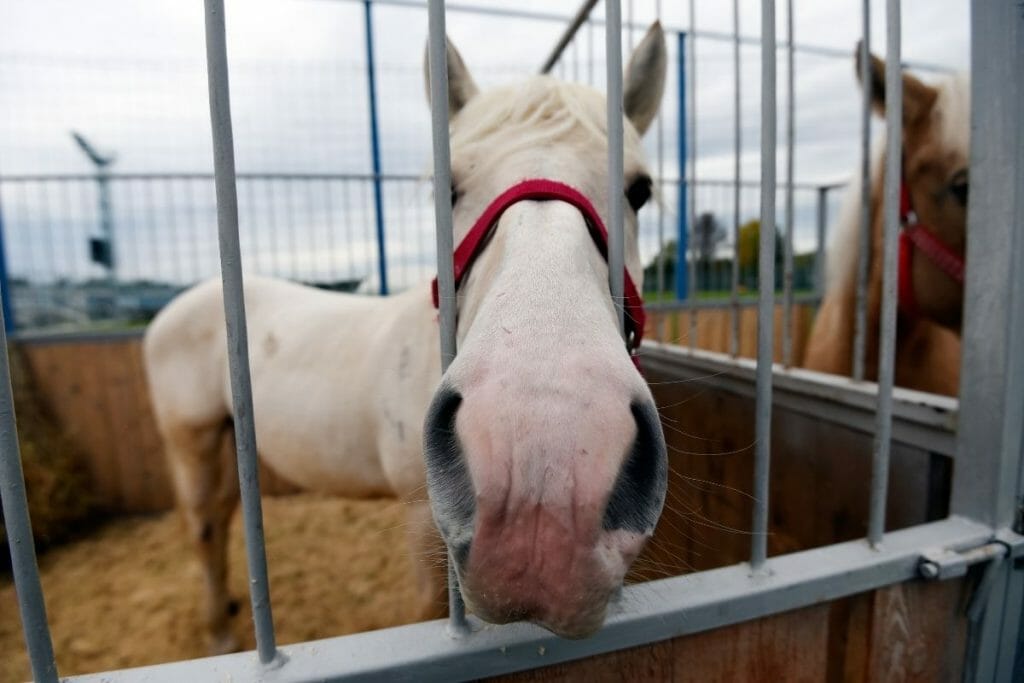
Naturally, horses are curious creatures. They are inquisitive immediately as foals, beginning to explore the new world as soon as they are born. This extends for the rest of their lives. Curiosity is the desire to find, experience, and discover new things.
Signs your horse is curious:
- The horse looks alert, but not fearful
- Head head high
- Ears pointed toward the thing they are curious about
- Eyes appear bright and wide but not so the whites are showing
Your Horse Is Saying They Are Happy
Horses that are happy and content are what we want our horses to feel. These are similar body language signs for a relaxed horse.
Signs your horse is happy:
- The lower jaw should be loose
- His lower mouth may hang down with a little bit of drool
- Nostrils relaxed and round
- The tail is loose and swings when they walk
- Ears could be many things, forward, sideways, back and forth while concentrating
- Rearing and running around, playing in the pasture
- Taking a deep breath or sigh
One of our main goals in our care and relationship with horses should be to see that our horses are happy and healthy.
A successful horse-human relationship, like any other, is based on good communications. While it may take some time to know your horse’s body language signs, by heart, mastering this skill will allow you to improve communication, training, care, and your relationship with your equine partner.
Horse Books About Horse Behavior & Communication
Disclaimer: The links below are to Amazon. If you click through and make a purchase right away I get a small commission. Thanks for your support. 🙂
- Horses in Translation: Essential Lessons in Horse Speak
- Horse Speak: An Equine-Human Translation Guide
- Horse and Pony Body Language Phrasebook
- How to Speak “Horse”: A Horse-Crazy Kid’s Guide to Reading Body Language and “Talking Back”
- Horse Behaviour: Interpreting Body Language and Communication
- The Body Language of Horses: Revealing the Nature of Equine Needs, Wishes and Emotions and How Horses Communicate Them
Posts In This Series
- Understanding Horse Behavior Before You Work With Horses: Equine Psychology Mini Series | Part 1 Intro
- Horses As Prey Animals: Equine Psychology Mini Series | Part 2
- Horses As Herd Animals: Equine Psychology Mini Series | Part 3
- Horse Instincts: Equine Psychology Mini-Series | Part 4
- Horse Communication 101: Equine Psychology Series Part 5
If you have any questions about horse communication or body language and it was not here. Send me an email [email protected] and I will consider adding it to the post or creating a Q&A section.
Cheers, Kacey

